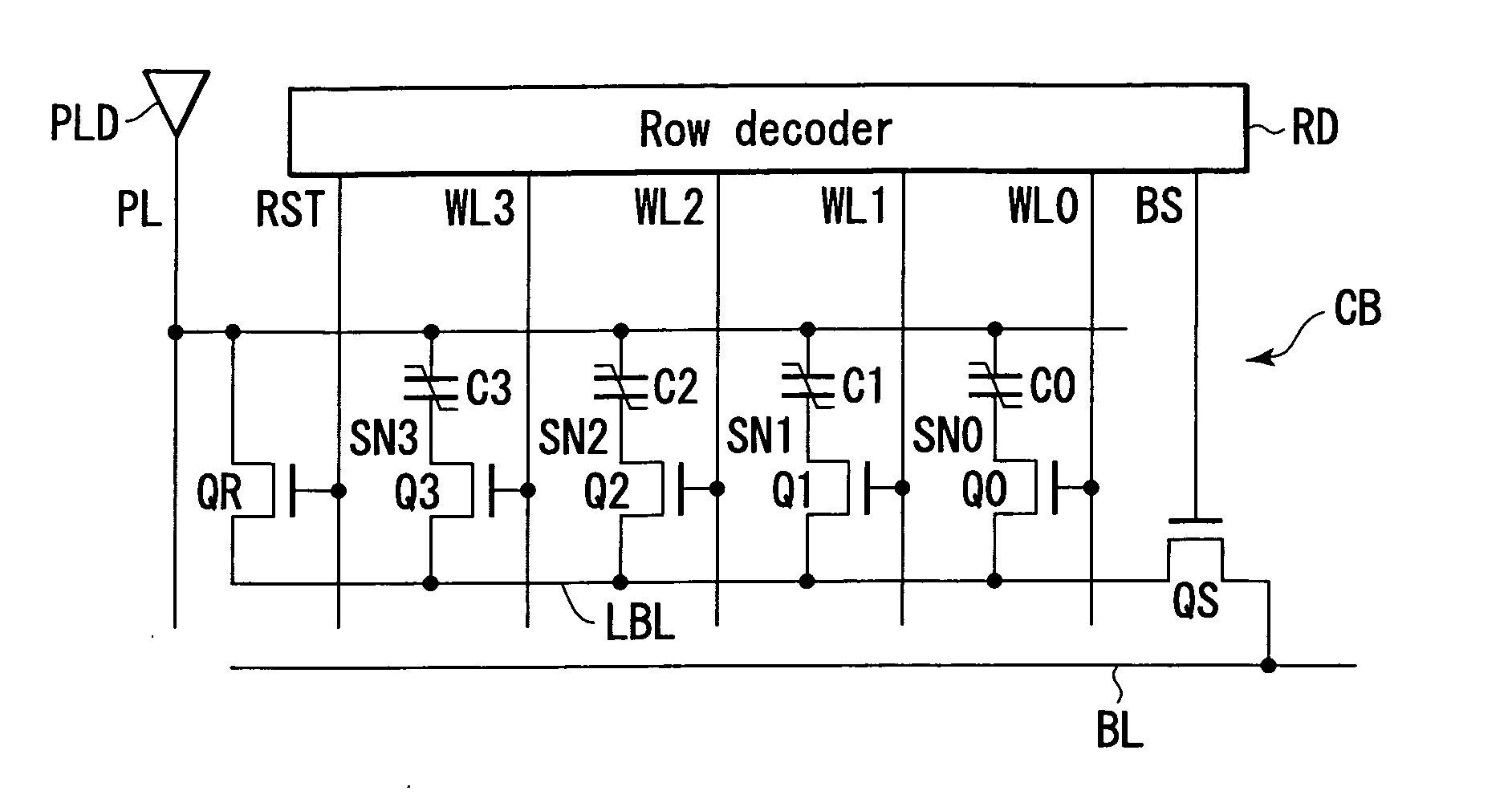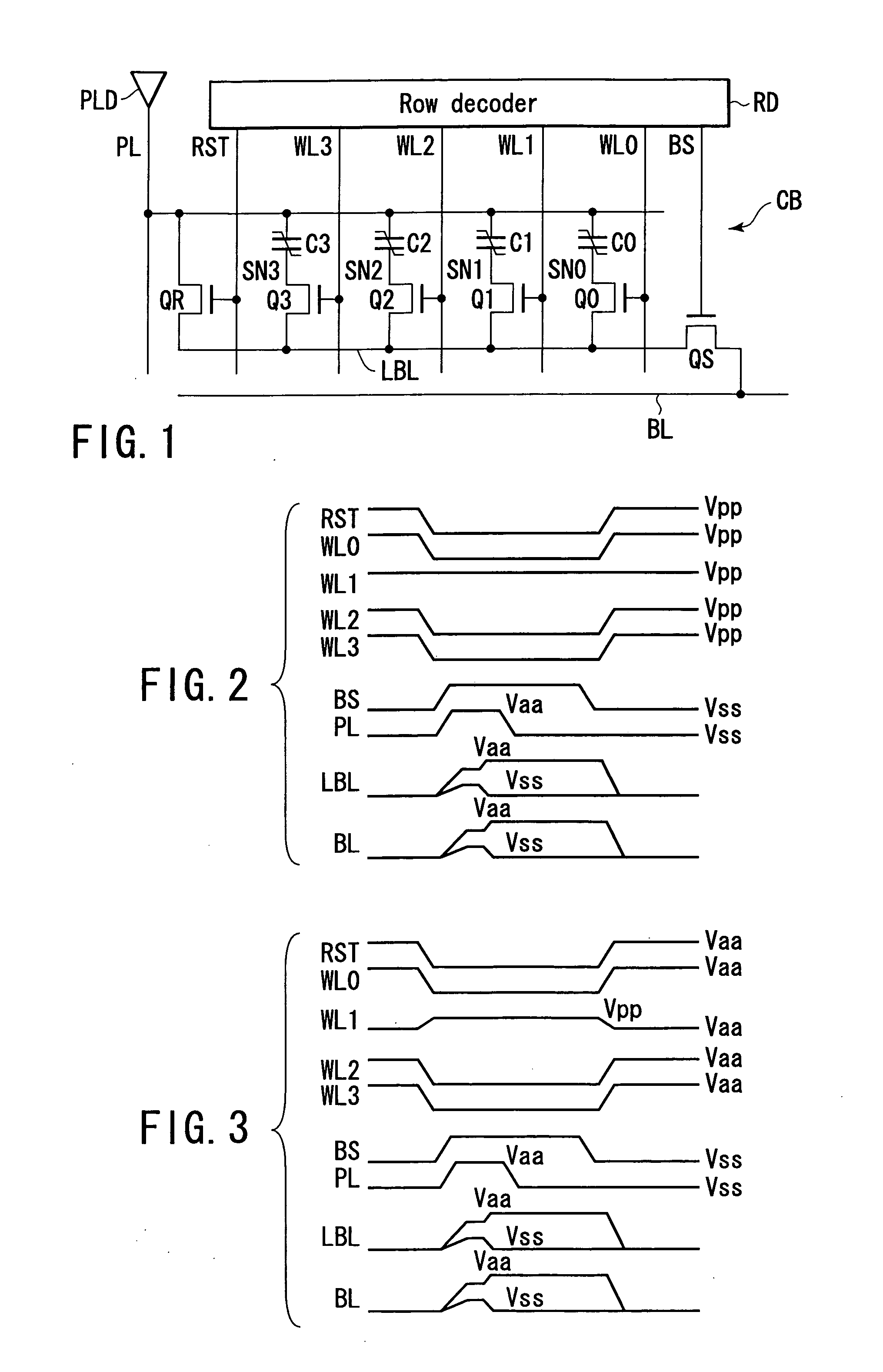Semiconductor integrated circuit device
a technology of integrated circuits and semiconductors, applied in the direction of information storage, static storage, digital storage, etc., can solve the problems of not being put on the market as wisely, the minimum cell size is limited to 2f4f=8f, and the size of the plate line drive circuit cannot be made larg
- Summary
- Abstract
- Description
- Claims
- Application Information
AI Technical Summary
Benefits of technology
Problems solved by technology
Method used
Image
Examples
first embodiment
[0118] (First Embodiment)
[0119]FIG. 1 shows the circuit configuration of a semiconductor integrated circuit device (FeRAM) according to a first embodiment of the present invention. As shown in FIG. 1, each memory cell includes one cell transistor and one ferroelectric capacitor which are connected in series. That is, the memory cells respectively include cell transistors Q0 to Q3 and ferroelectric capacitors C0 to C3. The gates of the cell transistors Q0 to Q3 are respectively connected to word lines WL0 to WL3. The memory cells are connected in parallel and one end of each memory cell is connected to a plate line PL and the other end thereof is connected to a local bit line LBL.
[0120] A reset transistor QR is connected between the plate line PL and the local bit line LBL. The reset transistor QR is controlled by a reset signal RST. Further, a block selection transistor QS is connected between the local bit line LBL and a bit line BL. The block selection transistor QS is controlled...
second embodiment
[0131] (Second Embodiment)
[0132] A second embodiment relates to one example of the driving method of the plate line PL of the semiconductor integrated circuit device of the first embodiment (FIG. 1). More specifically, the second embodiment relates a case wherein the potential of the plate line PL at the standby time is set to potential Vss and the potential thereof at the drive time is set to internal power supply potential Vaa.
[0133]FIG. 2 shows the operation of the semiconductor integrated circuit device of FIG. 1, for illustrating the second embodiment of the present invention. The operation is explained below by taking a case wherein information is read out from a ferroelectric capacitor C1 as an example.
[0134] As shown in FIG. 2, at the standby time, a reset signal RST and word lines WL0 to WL3 are set at potential Vpp (high level) and a block selection signal BS is set at potential Vss (low level). The plate line PL and bit line BL are set at potential Vss. Therefore, the c...
third embodiment
[0140] (Third Embodiment)
[0141] A third embodiment relates to one example of the driving method of the plate line PL of the semiconductor integrated circuit device of the first embodiment (FIG. 1). More specifically, the third embodiment relates to a case wherein the potential of the plate line PL is fixed at Vaa / 2.
[0142]FIG. 4 shows the operation of the semiconductor integrated circuit device of FIG. 1, for illustrating the third embodiment of the present invention. The operation is explained below by taking a case wherein information is read out from a ferroelectric capacitor C1 as an example.
[0143] As shown in FIG. 4, the state at the standby time is similar to that of the second embodiment except that the plate line PL is driven and set to Vaa / 2. At the active time, a reset signal RST and potentials of the word lines WL0, WL2, WL3 are set to a low level. In this state, the potential (=Vaa / 2) of the plate line PL is applied to one end of the ferroelectric capacitor C1 and the p...
PUM
 Login to View More
Login to View More Abstract
Description
Claims
Application Information
 Login to View More
Login to View More - R&D
- Intellectual Property
- Life Sciences
- Materials
- Tech Scout
- Unparalleled Data Quality
- Higher Quality Content
- 60% Fewer Hallucinations
Browse by: Latest US Patents, China's latest patents, Technical Efficacy Thesaurus, Application Domain, Technology Topic, Popular Technical Reports.
© 2025 PatSnap. All rights reserved.Legal|Privacy policy|Modern Slavery Act Transparency Statement|Sitemap|About US| Contact US: help@patsnap.com



